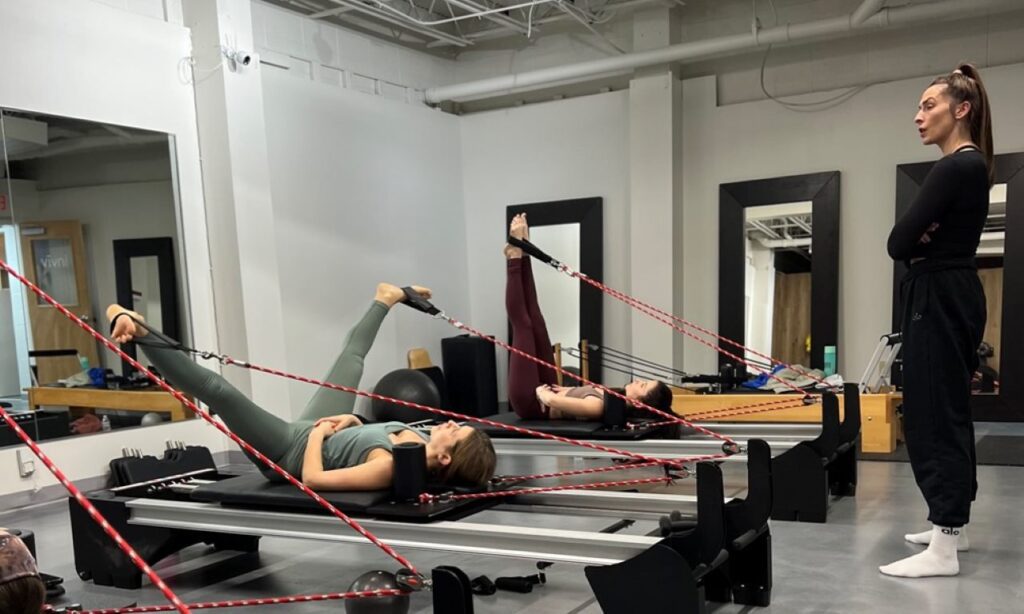Thursday, February 29th, 2024
Pilates, a form of exercise that has grown immensely in popularity over the past few decades, offers a unique blend of strength, flexibility, and mindfulness. Its appeal spans generations, having been popularized by celebrities like Jennifer Aniston in the 90s, while now resonating deeply with both millennials and Generation Z, who both value wellness and holistic health.
However, with its rise in popularity comes a diversification of practices – but just how many different types of pilates are there? In the following guide, we’re going to take a closer look at all the different types of Pilates, each offering a unique approach to achieving physical and mental well-being. So whether you’re a seasoned practitioner or new to the world of Pilates, understanding these variations can help you find the perfect match for your fitness journey. Let’s dive in!
The Evolution and Principles of Pilates
Origin and Founder
Pilates was developed in the early 20th century by Joseph Pilates, a physical trainer whose method was initially designed to rehabilitate soldiers returning from World War I. His approach was revolutionary, emphasizing the connection between the mind and body in achieving health and fitness. This holistic approach has since evolved, adapting to new knowledge and technologies, but the essence of Pilates remains unchanged.
Core Principles
At its heart, Pilates is grounded in core principles: concentration, control, centering, flow, precision, and breathing. These principles guide the practice, ensuring that it remains distinct and effective, regardless of the specific type being practiced; they’re the foundation that all types of Pilates build upon, aiming to enhance life quality through improved physical health, mental well-being, and a deeper sense of body awareness.
Mat Pilates
Mat Pilates is often considered the foundation of all Pilates exercises; it requires no special equipment beyond a mat, making it accessible and popular, and this type of Pilates focuses on core strengthening, flexibility, and overall body conditioning through a series of floor exercises. It’s an excellent starting point for beginners and provides a solid foundation for exploring other types of Pilates.
Reformer Pilates

Reformer Pilates introduces equipment into the practice, most notably the Pilates reformer; this machine, designed by Joseph Pilates himself, uses springs, a sliding carriage, and various attachments to create resistance. Reformer Pilates offers a more dynamic and versatile workout – allowing for a wider range of movements and a greater challenge to the muscles – and it’s particularly popular among those looking to deepen their practice and achieve specific fitness goals.
Clinical or Rehabilitation Pilates
Clinical or Rehabilitation Pilates is a therapeutic form of pilates that is often integrated into physiotherapy treatment plans. It’s generally tailored to individuals with specific injuries, conditions, or post-surgery recovery needs, and is modified to ensure safety and effectiveness, focusing on restoring movement, improving flexibility, and strengthening the body in a controlled and supervised environment.
Contemporary or Modern Pilates
Contemporary or Modern Pilates represents an evolution of the original method, incorporating knowledge from modern physical therapy, biomechanics, and exercise science; this approach adapts and evolves traditional exercises to meet today’s understanding of the body and its needs. It’s a more flexible and inclusive approach, making Pilates accessible to a wider audience, including athletes, the elderly, and those with specific physical challenges.
AeroPilates
Finally, AeroPilates combines traditional Pilates principles with the use of a reformer machine equipped with a rebounder at one end; this addition transforms the reformer into a low-impact cardiovascular workout machine, allowing for an effective aerobic workout that still emphasizes the Pilates principles of control, concentration, and precision. It’s an excellent option for those looking to combine strength training with cardiovascular health.
Choosing the Right Type of Pilates for You
With so many options available, selecting the right type of Pilates can seem like a daunting task – but it doesn’t have to be! All you need to do is simply consider your personal fitness goals, any existing health conditions, and your preferred learning environment. Whether you’re looking to achieve results with Pilates HIIT or seeking fitness with community support, there’s a Pilates type that aligns with your needs. And if you’re still not sure what class might be best for you, feel free to reach out to one of our experts at FitFlexFly – we’ll be happy to analyze your fitness profile and recommend you the class you’ll get the most benefit out of.
Final Thoughts
Ultimately, pilates is more than just a form of exercise; it’s a path to holistic health, offering strength, flexibility, and mental clarity – all in one neat package! So whether you’re drawn to the simplicity of Mat Pilates, the dynamic challenge of Reformer Pilates, or the therapeutic benefits of Clinical Pilates, there’s a space for you in any one of our classes.
FAQs
What should I wear to pilates classes?
For Pilates classes, it’s best to wear comfortable, form-fitting clothing that allows you to move freely and enables your instructor to observe your movements closely for proper form – and make sure to avoid clothing that’s too loose or too restrictive. Footwear isn’t typically required for Pilates, as exercises are often performed barefoot or with socks, preferably those with grips on the soles for stability.
How often should I do pilates to see results?
How often you perform Pilates will depend on your individual fitness goals, schedule, and the intensity of your workouts. Generally speaking, practicing Pilates 2-3 times a week can provide noticeable improvements in strength, flexibility, and posture – but remember that consistency is key to achieving and maintaining results.
Can pilates help with weight loss?
Pilates can be a component of a weight loss program. While it is primarily known for improving strength, flexibility, and the mind-body connection, it can also help with weight loss when combined with a balanced diet and regular cardiovascular exercise. Pilates exercises, especially those in a Pilates HIIT class or AeroPilates, can increase your heart rate and metabolic rate, contributing to calorie burn.

